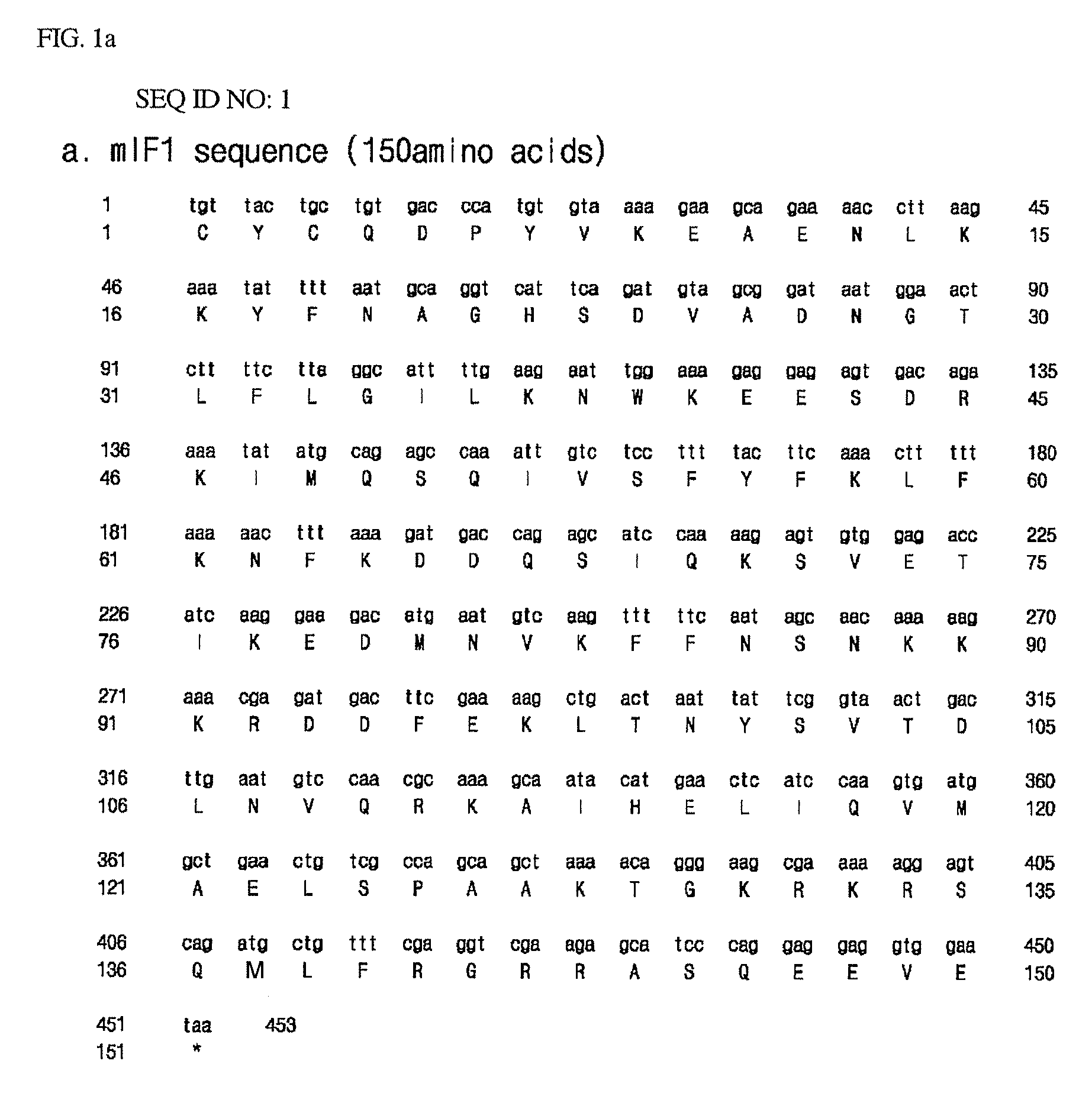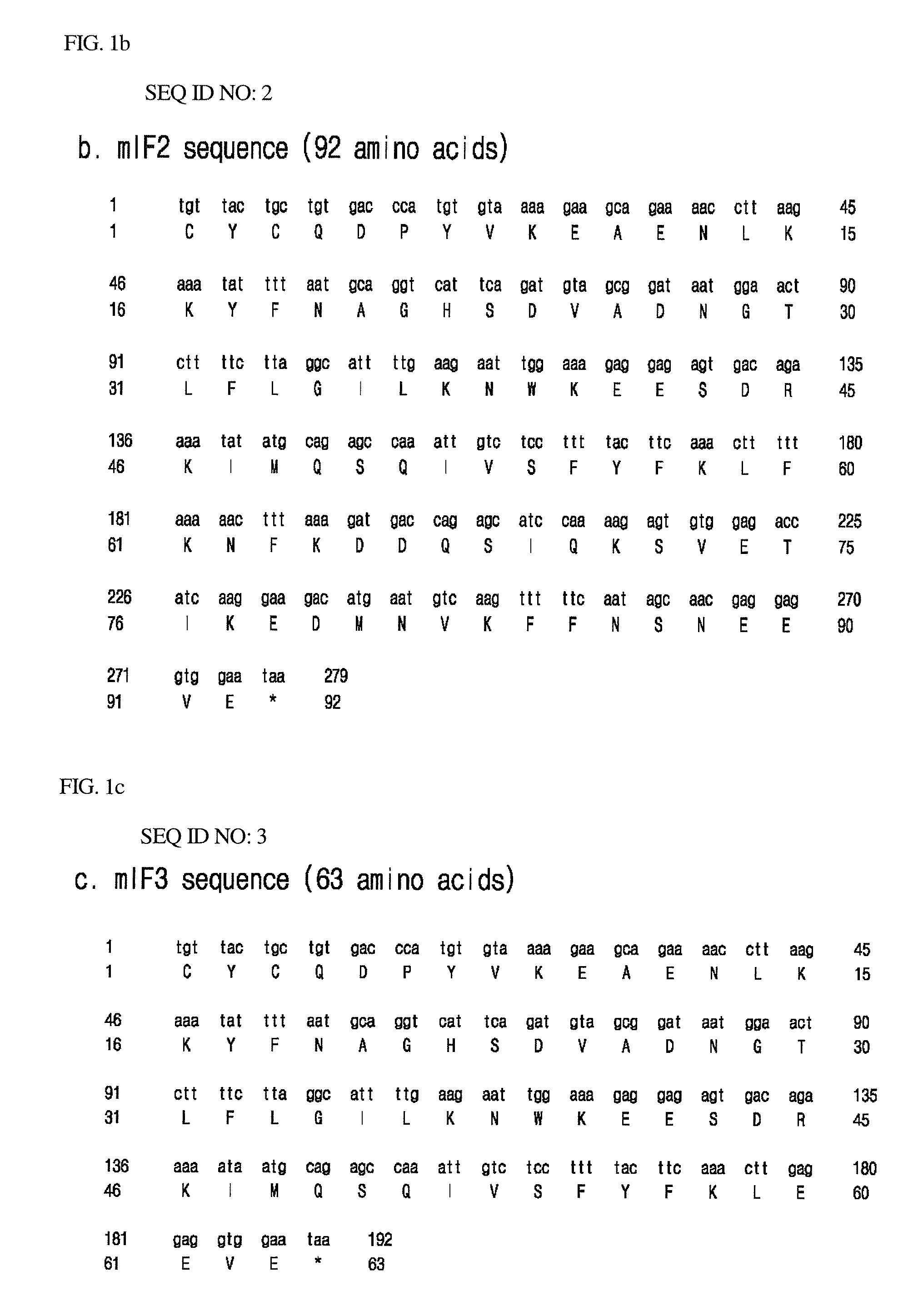Method for the mass expression of an antimicrobial peptide by co-expression of a basic antimicrobial peptide and an acidic peptide using a translational coupling system
a translational coupling and antimicrobial technology, applied in the field of gene constructs, can solve the problems of low production yield of desired peptides, economic inefficiency in producing antimicrobial peptides by chemical synthesis, and affecting the industrial application of antimicrobial peptides, so as to achieve convenient and efficient mass production of antimicrobial peptides and reduce the loss of productivity
- Summary
- Abstract
- Description
- Claims
- Application Information
AI Technical Summary
Benefits of technology
Problems solved by technology
Method used
Image
Examples
example 1
Amino Acid Sequencing of Acidic Proteins and Construction of Acidic Protein-Encoding Genes
[0053]For expression of histonin II (amino acid sequence: RAGLQFPVGRLLRRLLRRLLR) (SEQ ID NO: 6) that is a potent antimicrobial peptide having an amino acid sequence identical with a peptide of SEQ ID NO: 15 disclosed in Korean Patent No. 0314721, assigned to the present applicant and entitled “BIOLOGICALLY ACTIVE PEPTIDES”, acidic peptide candidates having the following characteristics were screened taking into consideration the charge distribution of histonin II:
[0054]1. Number and distribution of negative charges similar to the number and distribution of positive charges of histonin II,
[0055]2. Cysteine residue on the amino terminus,
[0056]3. Expression capacity in the form of an insoluble inclusion body, such that a peptide of interest can be stable against the attack of microbial proteases, and
[0057]4. Shorter peptide length for efficient production of an antimicrobial peptide.
[0058]For tra...
example 2
Construction of DNA Fragments for Co-Expression of Antimicrobial Peptides and Acidic Peptides
[0066]In order to construct a DNA fragment encoding an antimicrobial peptide histonin II gene, single-stranded oligomers were synthesized such as Primers 12 and 13 as set forth in Table 1. Then, a gene fragment encoding double-stranded histonin II was constructed by DNA polymerization (FIG. 2a). Herein, the carboxyl terminus of histonin II was provided with a BamHI recognition site (GGATCC) which will be used upon cloning of histonin II into a vector pET21c.
[0067]As shown in FIG. 2b, a DNA fragment for translational coupling of an acidic peptide and an antimicrobial peptide histonin II was constructed by recombinant PCR. In order to construct an mIF1-histonin II (mIF1H) DNA construct where an mIF1 DNA fragment and a histonin II DNA fragment were linked to elicit co-expression thereof, recombinant PCR was carried out using the histonin II double-stranded DNA fragment and the mIF1 DNA fragmen...
example 3
Construction of Translationally Coupled Vector of Acidic Peptide Gene-Antimicrobial Peptide Gene
[0068]For construction of the acidic peptide gene and the antimicrobial peptide gene synthesized in Examples 1 and 2 into a bicistronic expression vector, a translationally coupled structure was constructed where two cistrons are translationally coupled with each other, but they are independent from each other while being expressed in a state of overlapping with each other, as shown in FIG. 2. As a co-expression partner, an acidic peptide capable of neutralizing a basic antimicrobial peptide and forming an inclusion body was placed in the first cistron. The mIF1H, mIF2H or mIF3H DNA fragment constructed in Example 2 was placed in the second cistron to elicit expression of the antimicrobial peptide. For this purpose, the corresponding DNA fragment mIF1H, mIF2H or mIF3H was cleaved with restriction endonucleases NdeI and BamHI, and a DNA fragment having a desired size was separated using a...
PUM
| Property | Measurement | Unit |
|---|---|---|
| size | aaaaa | aaaaa |
| microbial resistance | aaaaa | aaaaa |
| basicity | aaaaa | aaaaa |
Abstract
Description
Claims
Application Information
 Login to View More
Login to View More - R&D
- Intellectual Property
- Life Sciences
- Materials
- Tech Scout
- Unparalleled Data Quality
- Higher Quality Content
- 60% Fewer Hallucinations
Browse by: Latest US Patents, China's latest patents, Technical Efficacy Thesaurus, Application Domain, Technology Topic, Popular Technical Reports.
© 2025 PatSnap. All rights reserved.Legal|Privacy policy|Modern Slavery Act Transparency Statement|Sitemap|About US| Contact US: help@patsnap.com



